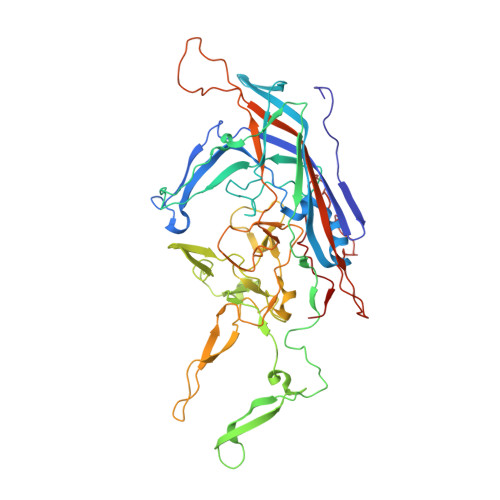Receptor Switching in Newly Evolved Adeno-associated Viruses.
Havlik, L.P., Das, A., Mietzsch, M., Oh, D.K., Ark, J., McKenna, R., Agbandje-McKenna, M., Asokan, A.(2021) J Virol 95: e0058721-e0058721
- PubMed: 34232726
- DOI: https://doi.org/10.1128/JVI.00587-21
- Primary Citation of Related Structures:
7LTM - PubMed Abstract:
Adeno-associated viruses utilize different glycans and the AAV receptor (AAVR) for cellular attachment and entry. Directed evolution has yielded new AAV variants; however, structure-function correlates underlying their improved transduction are generally overlooked. Here, we report that infectious cycling of structurally diverse AAV surface loop libraries yields functionally distinct variants. Newly evolved variants show enhanced cellular binding, uptake, and transduction, but through distinct mechanisms. Using glycan-based and genome-wide CRISPR knockout screens, we discover that one AAV variant acquires the ability to recognize sulfated glycosaminoglycans, while another displays receptor switching from AAVR to integrin β1 (ITGB1). A previously evolved variant, AAVhum.8, preferentially utilizes the ITGB1 receptor over AAVR. Visualization of the AAVhum.8 capsid by cryoelectron microscopy at 2.49-Å resolution localizes the newly acquired integrin recognition motif adjacent to the AAVR footprint. These observations underscore the new finding that distinct AAV surface epitopes can be evolved to exploit different cellular receptors for enhanced transduction. IMPORTANCE Understanding how viruses interact with host cells through cell surface receptors is central to discovery and development of antiviral therapeutics, vaccines, and gene transfer vectors. Here, we demonstrate that distinct epitopes on the surface of adeno-associated viruses can be evolved by infectious cycling to recognize different cell surface carbohydrates and glycoprotein receptors and solve the three-dimensional structure of one such newly evolved AAV capsid, which provides a roadmap for designing viruses with improved attributes for gene therapy applications.
Organizational Affiliation:
Curriculum in Genetics and Molecular Biology, University of North Carolina at Chapel Hillgrid.10698.36, Chapel Hill, North Carolina, USA.















